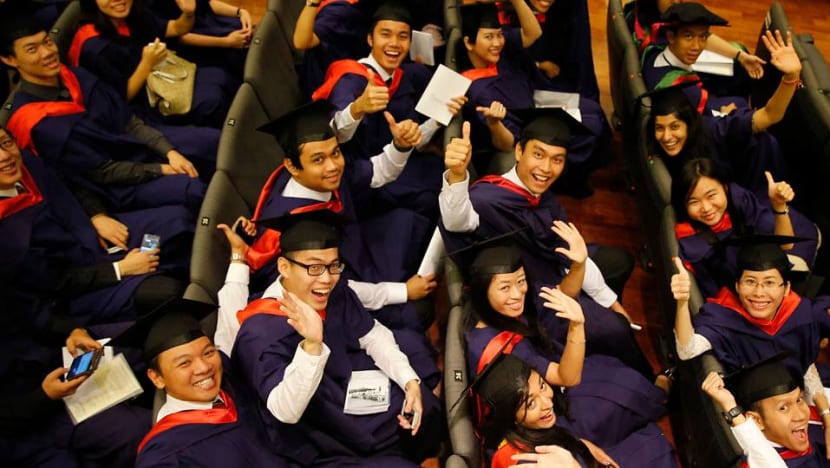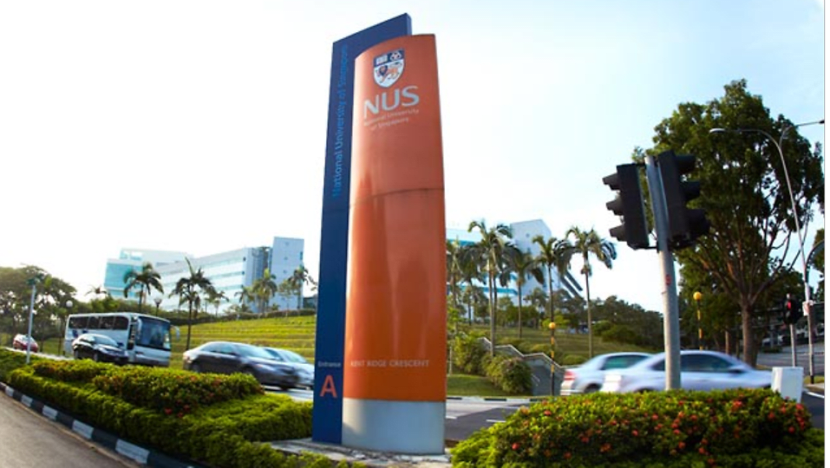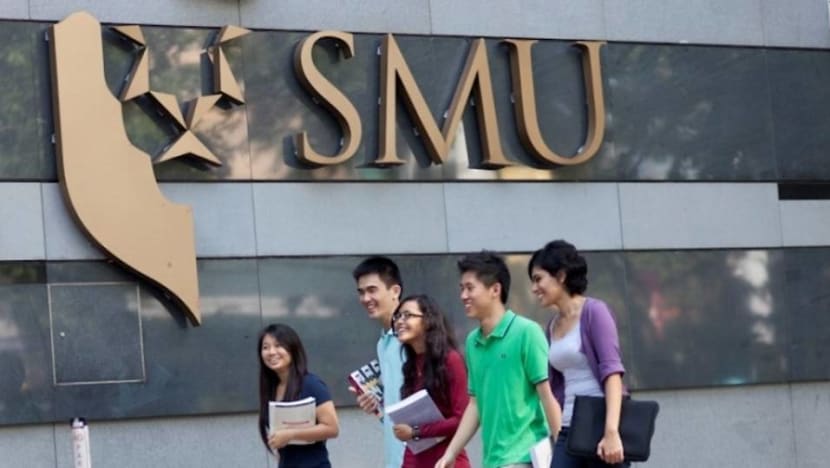commentary Commentary
Commentary: Time for Singapore universities to switch gears
Pursuing global rankings can have perverse effects, to the detriment of universities’ multifaceted mission, say two education experts.

National University of Singapore graduates at a commencement ceremony. (Photo: Lionel Lin)
SINGAPORE: Fifteen years after we started writing about global rankings and Singapore universities, it is gratifying to see Minister of Education Ong Ye Kung argue that rankings should not be based only on academic research publications, and NTU Assistant Professor Woo Jun Jie echo our argument that local and locally-oriented faculty, research and teaching are necessary.
We mostly agree with Minister Ong and Dr Woo, but would like to add some other important considerations.
Research universities in any country are “peak institutions” with complex multifaceted missions: “Pure” or “basic” research to advance human knowledge; “applied” research with practical policy and business implications; education to help individuals realise their human potential; professional training for job placement; and public service.
These missions are intertwined, not opposed to each other. Excellent universities perform well on all dimensions, which have local as well as global correlates.
READ: Singapore and Singaporeans lose when universities chase after world rankings, Woo Jun Jie's commentary
THE ISSUE WITH PURSUING GLOBAL RANKINGS
Our quarrel with the global rankings produced by Western commercial media outfits is that they overweight one of these missions judged by a singular metric — academic research published in “highly-ranked” peer-reviewed disciplinary journals and easily-measured “citation counts” and “impact factors”.
Such metrics privilege research of universal interest and relevance, undervaluing locally-specific research particularly in the humanities and social sciences.
Hiring and promotion of faculty, and faculty research choices based on these metrics, ends up restraining local faculty and local research.
“Chasing rankings” is also expensive, typically involving a global salary premium for scarce faculty talent in specialised fields.
READ: The age-old question about university rankings, a commentary

But universities are not just local vocational training institutes. Ranking them by (difficult-to-measure) contributions to industry and society, and graduates’ success in the current job market, risks undermining all aspects of their multi-faceted mission.
Given limited resources, including academic talent and faculty time, how can countries and institutions manage this balancing act?
OPTION 1: HAVING DIVERSE HIGHER EDUCATION INSTITUTIONS
One way is by differentiating among institutions, which happens in large countries with diverse, “tiered” higher education ecosystems, like the US and China, but also small Hong Kong, and other mainly public higher education systems.
Here, academic research is weighted more heavily in “research universities” with large postgraduate programmes, teaching commands more faculty time in “teaching universities” and undergraduate liberal arts colleges, and more vocationally-oriented institutions focus on job training and service to business and industry.
University offerings and faculty expectations differ accordingly.
Standardised rankings are meaningless in such systems, since an institution may rank highly on one mission or metric (say, academic research or undergraduate teaching) but low on another (say, student job placement or starting salary).
OPTION 2: HAVE DIFFERENT FACULTY TRACKS
Another way to cope with a multi-faceted mission is by having different faculty tracks in the same institution.
Tenure-track faculty for whom academic research publication is prioritised teach less than clinical or practice faculty with more practitioner-oriented research and industry consulting, and less than lecturers or adjuncts appointed full- or part-time purely for teaching.

Traditional ranking metrics which focus on academic research publication will thus mischaracterise an institution’s overall teaching or practice performance.
OPTION 3: HAVE A DIVISION OF LABOUR IN EACH FACULTY
A third option is to have faculty on the same track specialise in different functions depending on their individual capabilities and interests— a “portfolio” approach.
Within a particular academic department, all faculty teach, do research and some service (administration, committee work, student counselling), but some are more prominent in one function or another.
A division of labour based on individual comparative advantage then enables the department to perform well in every dimension of its mission.
OPTION 4: FACULTY SHIFT RESPONSIBILITIES OVER FACULTY MEMBERS’ CAREER LIFECYCLE
A fourth option is to have faculty on the same track change the weight of their responsibilities (time spent in a particular function) over the “life-cycle” course of their careers.
Junior tenure-track faculty focus on academic research publication, adding service obligations as they become more senior, and turning to administration and practitioner-oriented activities like government and industry consulting later in their careers.
Teaching and service may become more important in a senior faculty member’s “portfolio”.
This is practically what happens in US research universities, enabling them to excel in all functions, with a flexible corps of faculty, but without requiring rigid, standardised performance of every individual faculty member throughout her career — which following global research-based rankings would enforce.
RANKINGS CONSTRAIN UNIVERSITIES’ MISSION
In Singapore, it is not global rankings themselves which constrain universities’ ability to fulfil their mission, but making a fetish of them in faculty hiring, promotion, rewards and resource allocation.
Adding more metrics to rankings — especially without adding the resources to achieve them — will simply require more trade-offs from other functions, and risk reducing rather than improving overall institutional performance.

Foreign rankings companies will have difficulty properly evaluating contributions to national industry, public policy and social impact in diverse countries. Their attempts might even reinforce current ranking inequities favouring well-endowed and long-established institutions in Western countries, entrenching their standards of broader impact measurement.
Moving away from rankings entirely will mitigate the current rankings bias against local research, making it easier to attract scholars interested in such research to local universities.
A wider range of research topics, methodologies, academic and popular publication outlets would be considered in faculty hiring and promotion.
HOW MUCH LOCAL CONTENT DO WE NEED?
But “local content” cannot and should not be divorced from global disciplinary research questions, which can shed useful light on the local situation, and vice versa.
Faculty also need not have local empirical expertise to apply global disciplinary concepts locally, especially with the spread of interactive pedagogies that require and enable students to do so themselves – for instance through “action learning” and independent research.
For this, academic freedom is necessary, since critique is the rationale and lifeblood of all academic inquiry, and trains students in the original and critical thinking which citizens need and employers increasingly demand.
Both local and foreign faculty are more likely to engage students in applying and evaluating global theories in the Singapore context, including on locally sensitive subjects, if they are assured that their jobs, promotion prospects and visa status will not be compromised.
In preparation for the job market, the “local” in Singapore cannot be disentangled from our role as a global and regional hub: Understanding and navigating the social and cultural distinctiveness of the markets we serve is both necessary and a competitive advantage.
HIGHER EDUCATION IN A TECH-DRIVEN WORLD
With artificial intelligence (AI) soon able to handle routinised tasks, even in highly-skilled professional and technical areas, there is increased need for attention to “hyperlocal” specificities in tech-enabled markets, where AI will be slower to penetrate and niche customisation increasingly the norm.
Economic, social and business problems are inherently multidisciplinary. Leading universities are innovating in such areas as humanities education for medical and engineering students.

Tech companies increasingly look to hire graduates with an understanding of human behavior gleaned from studying history, literature, anthropology, psychology, drama and art, to help design products, perfect marketing algorithms, develop communications strategies, and handle customer relations.
This gives a practical edge to local and foreign Singapore university students’ frequently expressed wish for more local faculty and local and regional application of global curricular content.
SLOWING THE RETIREMENT OF PROFESSORS
Fortunately, there are “low-hanging fruit” that can be plucked to meet these wishes.
For example, most lecturers and adjuncts are locals, who could be given more opportunity to do research that can enhance their classroom teaching.
There are more locals among older than younger faculty cohorts, who could be encouraged and enabled to serve longer, particularly in teaching, service and practice functions, by raising the retirement age beyond 65, and providing post-retirement part-time teaching opportunities.
Retaining the services of faculty as long as possible is a sensible strategy, given the scarcity of local faculty, pressures on younger faculty to prioritise research, Singapore’s rapidly ageing population, the national move to encourage later retirement for fiscal and retirement adequacy reasons and the new emphasis on lifelong learning.
This will slow the decline in the ratio of local to foreign faculty, and reduce the faculty recruitment disadvantage of the shorter tenure of academic positions in Singapore than the US.
Decoupling from rankings can improve all (not just local) faculty recruitment, retention, research productivity, teaching excellence, civic participation and social contribution to Singapore and Singaporeans, simply by broadening faculty evaluation criteria, incentives and rewards.
Singapore’s universities can restructure themselves to reduce bureaucracy, increase flexibility, encourage academic freedom and reallocate resources to excel in their multi-faceted missions, without hewing to (even revised) global commercial rankings or rigid quotas favouring the hiring of local faculty.
Eschewing rankings is only a first step toward this transformation.
Linda Lim is Professor Emerita of Corporate Strategy and International Business at the Stephen M Ross School of Business at the University of Michigan. Pang Eng Fong is a former Professor of Strategic Management (Practice) at Singapore Management University.















